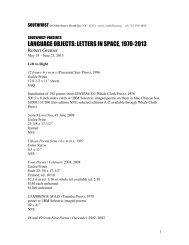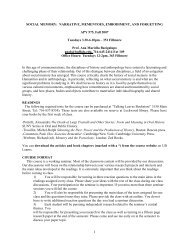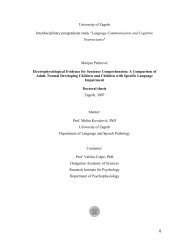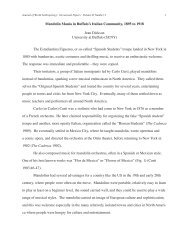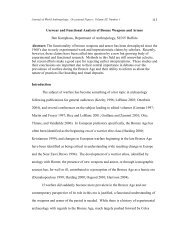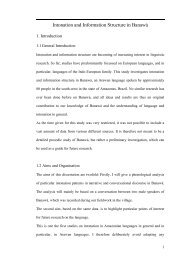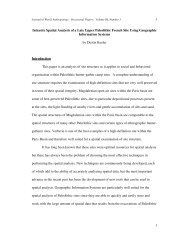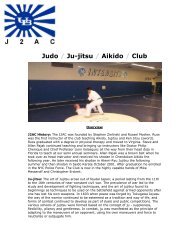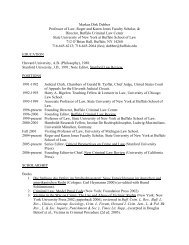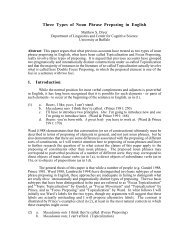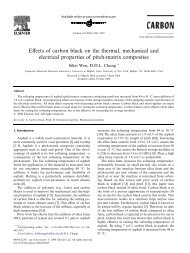DFA notes [Compatibility Mode] - Wings
DFA notes [Compatibility Mode] - Wings
DFA notes [Compatibility Mode] - Wings
You also want an ePaper? Increase the reach of your titles
YUMPU automatically turns print PDFs into web optimized ePapers that Google loves.
Design for Assembly and Manufacturing<br />
�� Sophisticated products involves involves a large number of<br />
individual components and subassemblies.<br />
subassemblies<br />
�� 70 to 80 percent of the cost of manufacturing a product<br />
is determined during the design phase<br />
�� A rational design for easy and low low-cost cost assembly is the<br />
selection of the most appropriate method for assembling<br />
these product product.<br />
�� So, a design Engineer should be concerned with the<br />
ease and cost of assembly. assembly<br />
�� Thus, the concept of design for assembly (<strong>DFA</strong>)<br />
emerged emerged.<br />
Design for Assembly
TYPES AND CHARACTERISTICS<br />
OF ASSEMBLY METHODS<br />
Manual Assembly<br />
�� In manual assembly, the operations are carried out<br />
manually with with or without the aid of simple, general-<br />
purpose tools like screwdrivers and pliers. pliers<br />
�� Individual components are transferred to the workbench<br />
either manually or by employing mechanical equipment<br />
such as parts feeds or transfer lines and then are<br />
manually assembled assembled.<br />
�� This assembly method is characterized by its flexibility<br />
and adaptability<br />
adaptability.<br />
�� The assembly cost per product is nearly constant<br />
�� Independent of the production volume.<br />
volume<br />
Design for Assembly
TYPES AND CHARACTERISTICS<br />
OF ASSEMBLY METHODS<br />
Automatic Assembly<br />
�� Mainly referred to as fixed automation or the Detroit type. type<br />
�� Either synchronous indexing indexing machines and automatic<br />
feeders or non-synchronous<br />
non synchronous machines where parts are<br />
handled by a free-transfer<br />
free transfer device are used. used<br />
�� Machines are dedicated for the production/assembly of a<br />
product product.<br />
�� These systems lack any flexibility to accommodate tangible<br />
changes in the design of the product. product<br />
�� Requires a large large-scale scale capital investment, as well as<br />
considerable time and engineering work before actual<br />
production can be started.<br />
started<br />
Design for Assembly
Types and characteristics of assembly methods<br />
Automatic Assembly Using Robots Robots / Robotic Robotic Assembly Assembly:<br />
�� Production volume is higher than that of a manual assembly<br />
system but lower than that of an automatic assembly system<br />
(Fixed automation).<br />
automation)<br />
Common forms of Robotic Assembly: Assembly<br />
1. One One-arm arm robot operating at a single workstation that includes<br />
parts feeders, magazines, etc etc.<br />
2. Two robotic arms operating at a single workstation<br />
�� A programmable controller (PLC) is used to simultaneously control<br />
and synchronize the motions of the two arms. arms<br />
�� Referred as a robotic assembly cell and similar to FMS cell. cell<br />
3. Multi Multi-station station robotic assembly system<br />
�� Capable of performing several assembly operations simultaneously.<br />
simultaneously<br />
�� Can perform different assembly operations at each station. station<br />
�� High flexibility and adaptability to design changes. changes<br />
Design for Assembly
Assembly cost per product<br />
Comparison of Assembly Methods<br />
�� Manual assembly requires the least capital investment followed by the<br />
two simplest forms of robotic assembly. assembly<br />
�� Multi Multi-station station robotic assembly system compares to Automatic system<br />
with special-purpose<br />
special purpose machines requires more capital investment for a<br />
large production volume but less capital investment for a moderate<br />
production volume volume.<br />
�� Assembly cost per product is constant for manual assembly<br />
Robotic assembly<br />
Annual Production Volume<br />
Manual assembly<br />
Automatic assembly<br />
using special purpose<br />
machine<br />
�� Assembly cost per product is<br />
decreases linearly with increasing<br />
production volume for automatic<br />
assembly<br />
machines machines.<br />
using special-purpose<br />
special purpose<br />
�� In the case of robotic assembly, the<br />
assembly cost per product decreases<br />
with increasing production volume, but<br />
becomes less economical after<br />
exceeding the annual production<br />
volume at a certain point. point<br />
Design for Assembly
SELECTION OF ASSEMBLY METHOD<br />
Factors affecting selection of an<br />
assembly method method:<br />
�� Cost of assembly<br />
�� Annual production volume (or<br />
production rate),<br />
�� Number of individual components<br />
to be assembled in a product<br />
�� Number of different versions of a<br />
product / s<br />
�� Availability of labor (with cost<br />
consideration)<br />
�� Payback period<br />
- These factors are interactive<br />
Impossible to have a single<br />
mathematical relationship between<br />
these factors factors.<br />
- Impossible<br />
Design for Assembly
PRODUCT DESIGN FOR MANUAL ASSEMBLY<br />
To design products for manual assembly we need to reduce both the<br />
assembly time and the skills required of assembly workers. workers<br />
Guidelines for product design for manual assembly: assembly<br />
�� Eliminate the need for any decision making by the assembly worker,<br />
including his or her her having to make any final adjustments.<br />
�� Ensure accessibility and visibility.<br />
�� Eliminate the need for assembly tools or special gages by designing the<br />
individual components to be self-aligning<br />
self aligning and self-locating<br />
self locating. Figure: Figure it is<br />
far easier and takes less time to insert the pin with the chamfer chamfer.<br />
�� Minimize the types of parts by adopting<br />
the concept of standardization as a<br />
design philosophy philosophy.<br />
�� Expand the use of multifunction and<br />
multipurpose components<br />
components.<br />
Design for Assembly
DESIGN FOR MANUAL ASSEMBLY continue…<br />
�� Minimize the number of individual parts in an assembly by eliminating<br />
excess parts and, whenever possible, integrating two or more parts<br />
together, as handling lesser parts are much easier. easier<br />
�� The criteria for reducing the parts count per assembly, established by<br />
G. Boothroyd and P Dewhurst involve negative answers to the<br />
following questions :<br />
�� Does the part move relative to all other parts already assembled?<br />
�� Must the part be of a different material or be isolated from other parts<br />
already assembled?<br />
�� Must the part be separate from all other parts already assembled because<br />
otherwise necessary assembly or disassembly of other parts would be<br />
impossible?<br />
�� Avoid or minimize reorienting the parts during assembly. assembly Try to make<br />
all motions simple by, for example, eliminating multi-motion<br />
multi motion insertions. insertions<br />
�� Design parts having maximum symmetry in order to facilitate easy<br />
orientation and handling during assembly.<br />
assembly<br />
Design for Assembly
PRODUCT DESIGN FOR AUTOMATIC ASSEMBLY<br />
Parts are required to be: be uniform uniform; high quality; quality have tighter geometric<br />
tolerances, to eliminate any downtime of the assembly system due to parts<br />
mismatch or manufacturing defects. defects<br />
Important factors involves orientation, handling, and feeding of parts to the<br />
assembly machine machine. Rules for automatic assembly are: are<br />
�� Reduce the number of different components in an assembly by using the<br />
three questions listed previously. previously Figure LHS<br />
�� Use self-aligning<br />
self aligning and self-locating<br />
self locating features like chamfers, guidepins,<br />
dimples, and certain types of screws, in parts to facilitate the process of their<br />
assembly assembly. Figure RHS.<br />
RHS<br />
Design for Assembly
DESIGN FOR AUTOMATIC ASSEMBLY continue…<br />
�� Avoid, if possible, fastening by screws as it is<br />
expensive and time-consuming<br />
time consuming.<br />
�� Thus, recommended to design parts that will<br />
snap together or be joined together by a press<br />
fit fit. (May lead to problems while disassembling<br />
the product for maintenance.)<br />
maintenance<br />
�� If screws must be used, then unify their types<br />
and head shapes. shapes Figure Figure.<br />
�� Make the largest and most rigid part of the<br />
assembly as a base or fixture where other parts<br />
are stack stack-assembled assembled vertically in order to take<br />
advantage of gravity gravity. This will eliminate the<br />
need for employing an assembly fixture. fixture<br />
�� Seek the use of standard components and/or<br />
materials, i.e. a high percentage of standard<br />
parts in any new design design. Group technology can<br />
be adopted to achieve this goal.<br />
goal<br />
Design for Assembly
PRODUCT DESIGN FOR AUTOMATIC ASSEMBLY<br />
continue…<br />
�� Avoid the possibility of parts tangling,<br />
nesting, or shingling during feeding.<br />
Figure.<br />
�� Avoid flexible, fragile, and abrasive<br />
parts and ensure that the parts have<br />
sufficient strength and rigidity to<br />
withstand the forces exerted on them<br />
during feeding and assembly. assembly<br />
�� Avoid reorienting assemblies because<br />
each reorientation may require a<br />
separate station or a machine, both of<br />
which cause an appreciable increase<br />
in cost.<br />
cost<br />
Design for Assembly
PRODUCT DESIGN FOR AUTOMATIC ASSEMBLY<br />
continue…<br />
�� Design parts to ease automation by by presenting or admitting the<br />
parts to the assembly machine in the right orientation after the<br />
minimum possible time in the feeder.<br />
�� The process in the feeder consists<br />
of rejecting parts resting in any<br />
position but the one desired desired.<br />
�� Figure shows the effect of the<br />
possible number of orientations on<br />
the efficiency of feeding feeding.<br />
�� According to W. V. Tipping, two<br />
types of parts can easily be<br />
oriented oriented:<br />
- Parts symmetrical in shape (e.g., (e a<br />
sphere or cube)<br />
- Parts with clear asymmetry (either<br />
in shape or weight) weight).<br />
Design for Assembly
PRODUCT DESIGN FOR AUTOMATIC ASSEMBLY<br />
continue…<br />
�� Figure shows some small<br />
changes in the design of parts<br />
that result in full symmetry symmetry.<br />
�� It is easy to achieve symmetry<br />
with sheet metal and injection-<br />
molded parts because the<br />
manufacturing cost of adding a<br />
feature is relatively low low.<br />
�� If it is too difficult or too expensive to<br />
achieve symmetry, nonfunctional<br />
features must then be added to make<br />
identification and grasping easier as<br />
shown in Figure.<br />
Figure<br />
Design for Assembly
PRODUCT DESIGN FOR ROBOTIC ASSEMBLY<br />
�� The product design rules for robotic assembly are<br />
basically the same as those for manual manual and/or automatic<br />
assembly assembly.<br />
�� Two very important and crucial considerations that have<br />
to be taken into account when designing components for<br />
robotic assembly: assembly<br />
Design a component so that it can be grasped, oriented,<br />
and inserted inserted by that robot's robot's end effector. effector Failure to do so<br />
will result in the need for an additional robot and,<br />
consequently, higher assembly cost. cost<br />
1. Design<br />
Design parts so that they can be presented to the robot's<br />
arm in an orientation appropriate for grasping. grasping Also,<br />
eliminate the need for reorienting assemblies (or<br />
subassemblies) during the assembly operation.<br />
operation<br />
2. Design<br />
Design for Assembly
METHODS FOR EVALUATING AND IMPROVING<br />
PRODUCT <strong>DFA</strong><br />
�� Methods are based on measuring the ease or difficulty with<br />
which parts can be handled and assembled together together into a<br />
given product product.<br />
�� An analytical procedure is followed where the problems<br />
associated with the components design are detected and<br />
quantitatively assessed. assessed<br />
�� Most commonly used methods: methods<br />
�� The Boothroyd Boothroyd-Dewhurst Dewhurst <strong>DFA</strong> Method<br />
�� The Hitachi Assembly Evaluation Method<br />
�� The Lucas <strong>DFA</strong> Method<br />
�� The Fujitsu Productivity Evaluation System<br />
Design for Assembly
The Boothroyd Boothroyd-Dewhurst Dewhurst <strong>DFA</strong> Method<br />
�� Developed in the late 1970s 1970 by Professor Geoffrey Boothroyd, at the<br />
University of Massachusetts, Amherst in cooperation with Salford University<br />
of England England.<br />
�� The analysis cannot be employed to create a design from nothing but rather<br />
is used to evaluate and refine an existing design. design<br />
�� First, the appropriate assembly method is selected by means of charts. charts<br />
�� Then, the analytical procedure<br />
corresponding to the assembly method<br />
selected is used (i (i.e., there is a separate,<br />
though similar, procedure for each of the<br />
assembly methods) methods).<br />
�� Figure shows the stages of the Boothroyd- Boothroyd<br />
Dewhurst <strong>DFA</strong> method method.<br />
Design for Assembly<br />
Analyze for<br />
manual<br />
assembly<br />
Select the<br />
Assembly method<br />
Analyze for<br />
High-speed<br />
automatic<br />
assembly<br />
Improve the<br />
design and<br />
reanalyze<br />
Analyze for<br />
robotic<br />
assembly
The Boothroyd Boothroyd-Dewhurst Dewhurst <strong>DFA</strong> Method continue…<br />
�� The first step is to determine the assembly sequence sequence.<br />
�� The assembly time for each component part is then obtained by adding the<br />
handling time of that part to its insertion time time.<br />
�� Once the components and the assembly time for each are known, total assembly<br />
time and assembly cost for the existing design is evaluated evaluated.<br />
�� The next step is aimed at reducing the parts count by eliminating or combining<br />
some parts. parts (as per the 3 questions described before). before) Thus finding finding “theoretically<br />
needed” parts parts.<br />
�� A design efficiency index is used to evaluate the improvement in design in a<br />
quantitative manner, given by by:<br />
Design Efficiency = (3* Nm) / calculated total assembly time<br />
where Nm is the theoretical minimum number of parts. parts<br />
Assumption<br />
Assumption: total ideal assembly time 3 seconds seconds.<br />
�� Design is improved by reviewing the worksheet and eliminating components that<br />
have relatively high handling and insertion times times.<br />
�� This process is repeated until an optimal design is obtained obtained.<br />
Design for Assembly
The Boothroyd Boothroyd-Dewhurst Dewhurst <strong>DFA</strong> Method continue…<br />
Boothroyd<br />
and<br />
Dewhurst<br />
proposed the<br />
worksheet<br />
shown for<br />
effective<br />
bookkeeping<br />
of the<br />
assembly<br />
time and<br />
cost.<br />
DISADVANTAGE:<br />
Decreasing the parts count could result in the manufacture and use of complex<br />
components. Since assembly cost is normally 5% of total cost, the final product<br />
could be easy to assemble but expensive to manufacture.<br />
Design for Assembly
The Hitachi Assembly Evaluation Method (AEM)<br />
�� Originally, employed to refine the designs of tape recorder mechanisms<br />
in order to develop an automatic assembly system for producing those<br />
subassemblies<br />
subassemblies.<br />
�� The method does not explicitly distinguish between manual and<br />
automatic assembly, this difference is accounted for implicitly within the<br />
structured analysis analysis.<br />
�� The Hitachi AEM approach is based on assessing the assemblability of<br />
a design based on two indices indices:<br />
1. An<br />
An assemblability evaluation score (E) is used to assess design quality<br />
or difficulty of assembly operations operations.<br />
�� The procedure to compute E is based on considering the simple downward<br />
motion for inserting a part as the "ideal reference reference.“<br />
�� For complicated operations, penalty scores that depend upon the complexity<br />
and nature of each operation are assigned.<br />
assigned<br />
Design for Assembly
Hitachi Assembly Evaluation Method continue…<br />
�� The Hitachi method uses symbols to<br />
represent operations, and there are<br />
about 20 of them covering<br />
operations operations. Ex Ex: shown in figure. figure<br />
�� After completing a worksheet penalty<br />
score for each part is manipulated to<br />
give the assemblability evaluation<br />
��<br />
score for that part part.<br />
E values for all parts are then combined to produce an assemblability<br />
evaluation score for the whole assembly. assembly<br />
2. An estimated assembly cost ratio (K) is an indication of the assembly cost<br />
improvements<br />
improvements.<br />
�� K is the ratio between the assembly cost of the new (modified) design divided by<br />
the assembly cost of the initial and/or standard design design.<br />
�� The method of estimating the time (and cost) of an operation involves breaking<br />
it into its elemental components and allocating time for each elemental motion<br />
based on compiled practical observations.<br />
observations<br />
�� Any saving in the assembly cost can be achieved by reducing the parts count in<br />
a product and/or simplifying the assembly operations operations.<br />
Design for Assembly
Lucas <strong>DFA</strong> Method<br />
�� Unlike the previous two methods, the<br />
Lucas <strong>DFA</strong> evaluation is not based on<br />
monetary costs, but on three indices that<br />
give a relative measure of assembling<br />
difficulty difficulty.<br />
�� The goal of reducing the parts count and<br />
the analysis of the insertion operations<br />
are shared with the previous two method. method<br />
�� Analysis is carried out in three sequential<br />
stages as shown in Assembly Assembly-sequence sequence<br />
flowchart diagram: diagram<br />
�� Functional<br />
�� Feeding (or handling)<br />
�� Fitting analyses.<br />
analyses<br />
Design for Assembly
Lucas <strong>DFA</strong> Method continue…<br />
Functional analysis analysis:<br />
�� Components are divided into two groups. groups<br />
�� Components that perform a primary function (essential components) or<br />
"A" parts parts.<br />
�� Nonessential, or "B," components functions like fastening and locating. locating<br />
that perform only secondary<br />
�� Design efficiency is given by: by<br />
Design Efficiency = 100 * A / (A+B)<br />
�� If the design efficiency is low, it is improved by eliminating most of the<br />
nonessential parts parts.<br />
�� Initial stage target is to achieve a design efficiency of 60 percent. percent<br />
Feeding analysis: analysis<br />
�� Concerned with the problems associated with handling components (or<br />
subassemblies) until they are admitted to the assembly system. system<br />
�� Feeding /handling index is calculated based on size, weight, handling<br />
difficulties, and orientation of a part. part<br />
�� Feeding /handling ratio can be calculated as: as<br />
Feeding/handling ratio = (Feeding/handling index) / Number of essential<br />
components<br />
�� An ideal value for this ratio is 2.5.<br />
Design for Assembly
Lucas <strong>DFA</strong> Method continue…<br />
Fitting analysis .<br />
�� The fitting analysis is divided into a number of subsystems including<br />
gripping, insertion, and fixing analyses analyses.<br />
�� An index is given to each part based on its fixturing requirements,<br />
resistance to insertion, and whether or not there will be restricted vision<br />
during assembly. assembly<br />
�� High individual values and/or a high total value of these indices means<br />
costly fitting operations. operations<br />
�� The fitting index is manipulated to yield the fitting ratio as: as<br />
fitting ratio = fitting index / number of essential components<br />
�� For acceptable design fitting ratio should be 2.5.<br />
Feeding /handling and fitting ratios are used as "measures of<br />
performance" to indicate the effectiveness of the design quality with<br />
respect to assembly<br />
DISAADVANTAGE<br />
DISAADVANTAGE: Does not considers the manufacturing cost while<br />
making design changes, which can lead to a costly part.<br />
part<br />
Design for Assembly
The Fujitsu Productivity Evaluation System<br />
�� Unlike other <strong>DFA</strong> methods it is not a refinement procedure after completion<br />
of the detailed design design. Rather it can be described as: as<br />
�� A software package which can be used as a tool to aid in obtaining a<br />
detailed design that is easy to manufacture and assemble with cost<br />
effectiveness<br />
effectiveness.<br />
�� Limited to bench bench-type type manual assembly of relatively small parts.<br />
�� Consists of four subsystems as shown in figure, based upon making full use<br />
of an expert system involving practical manufacturing and design data and<br />
rules of thumb gathered from experience.<br />
experience<br />
�� The software addresses a problem by<br />
carrying out a rough evaluation that<br />
can be followed by detailed<br />
evaluations made concurrently with<br />
the product development process process.<br />
Design for Assembly<br />
Assemblability<br />
Evaluation subsystem<br />
Assembly sequence<br />
specification subsystem<br />
Design ideas and<br />
know-how reference subsystem<br />
Manufacturability<br />
Evaluation subsystem
The Fujitsu PES continue…<br />
�� Figure indicates the procedure for applying the productivity evaluation<br />
system throughout the product development cycle. cycle<br />
Assembly sequence specification subsystem:<br />
subsystem<br />
�� Designer selects parts similar to those envisioned to be used in the<br />
product and then specifies their assembly sequence. sequence<br />
�� The system promptly retrieves<br />
previously stored values for<br />
assemblability and manufacturability<br />
that can be used by the evaluation<br />
subsystem to obtain assembly time<br />
and cost cost.<br />
Design for Assembly
The Fujitsu PES continue…<br />
Assemblabllity evaluation subsystem:<br />
subsystem<br />
�� Estimates assembly time and evaluate the ease of assembly, based<br />
upon a library of subassemblies and their number of essential parts that<br />
are stored by functional module. module<br />
Ex Ex: Printing module includes dot printing (10 10 essential parts). parts)<br />
�� Analysis addresses the handling and insertion of parts, specifies the<br />
target number of essential parts, and identifies high-cost high cost processes and<br />
parts parts.<br />
�� Figure shows operation of this, and types of input and output data.<br />
data<br />
Design for Assembly
The Fujitsu PES continue…<br />
Assemblabllity evaluation subsystem<br />
continue continue…<br />
�� System breaks down the assembly<br />
time of each part into handling<br />
time, insertion time, and so on, and<br />
displays it as a bar chart. chart See<br />
Figure (a). (a)<br />
Design for Assembly<br />
�� System also shows the<br />
assemblability evaluation score for<br />
the whole product as well as for<br />
assembly and adjustment<br />
operations operations. See Figure (b).<br />
(b)
Manufacturability evaluation<br />
subsystem:<br />
�� Used as a tool by the<br />
designer to estimate the<br />
manufacturing cost and<br />
evaluate<br />
manufacturability in a<br />
quantitative manner manner. See<br />
Figure Figure.<br />
�� Can be done at two<br />
levels : rough evaluation<br />
or/and a detailed one one.<br />
The Fujitsu PES continue…<br />
DISADVANTAGE<br />
DISADVANTAGE:<br />
Based on retrieving previously compiled data which are gathered during<br />
production production. So, may only be successful for products identical or similar to<br />
those within the range of products of that company.<br />
company<br />
Design for Assembly
Design for Automation<br />
�� Crucial steps to improve Automation<br />
�� Concurrent Design<br />
�� Early Design of Assembly<br />
�� Simultaneous design for Manufacturing<br />
�� Design for Quality or Design for Six Sigma<br />
�� A good Automation is not a cure for poor design<br />
Design for Assembly
Future of Automation<br />
�� More advanced knowledge of the effect of design<br />
in your product<br />
�� Virtual Prototyping<br />
�� Multi Multi-purpose purpose robots capable of carrying out<br />
several manufacturing activities<br />
�� Metal based Rapid Prototyping<br />
�� Highly Custom made products<br />
�� Capability to ‘intelligently configure’ products that can be<br />
manufactured quickly<br />
�� ???<br />
Design for Assembly


![DFA notes [Compatibility Mode] - Wings](https://img.yumpu.com/5083820/1/500x640/dfa-notes-compatibility-mode-wings.jpg)

